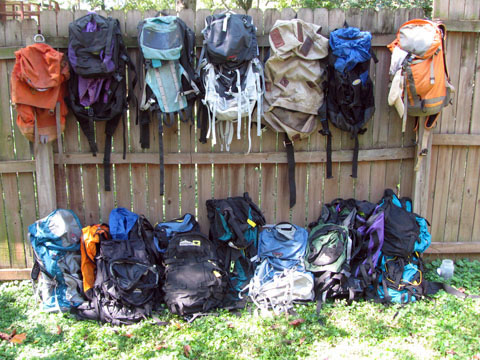| 483 | Trail Sense - Choosing a Pack | 2011-09-26 |

The backpack is a lightweight bag with straps that attaches to your back and is home to all of your outdoor gear. A single backpack often times contains your house, bed, kitchen, pantry, wardrobe, and bathroom.
We have many packs that live in our garage. We have large packs and small packs. One large empty pack weighs 8 pounds and a couple of ounces. One small pack weighs just a few ounces. The heavy pack is tough, large, with lots of straps and extras. The small pack is made of lightweight nylon, small in size, and with no extras. Somewhere in between the two packs is the perfect pack.
When shopping for a backpack chose it wisely.
Purpose - The two broad categories are day packs and overnight packs. Most day packs are under 2500 cubic inches (41 liters).
Fit - This is not a good product to buy online, unless you are positive of the size and fit. Try the pack on and see if it is comfortable. Load the pack and see if it still comfortable. Some outdoor stores have "pack fitters" who will measure your spine and choose the perfect pack for you. Still try as many packs on as possible. A pack buyer should be as finicky as a shoe buyer.
Features:
Frame Type - I have never been able to tell the difference in the types of internal frames while wearing the pack. Personally I enjoy a simple design such as a stiff foam back or simple struts. I haven't carried an external frame pack since the '70's. I was not even considering them as a possibility; but if you like them, then have at 'em.
Access - I would only choose a top loading pack. I have had front loading packs that used a zipper. All is well until the zipper fails and you are strapping the opening closed. It is not a pretty sight.
One Large Compartment - The more the pack is divided the harder it is to pack.
Top Compartment - I like a top compartment. If I was using a pack without a top compartment, I would use a ditty sack about the same size and weight as the top compartment for the same purpose as the top compartment. Many packs offer detachable top compartments.
Outside Pockets - The net outside pockets are especially nice. They add storage for extra gear on extended trips without much weight.
Hydration System - If you carry a water bladder, then choose a pack designed to carry a hydration system.
Compression Straps - The straps are used to compact the load. Sometimes they are useful, but the straps should be a simple and made of lightweight materials.
Waist Belt - Since I generally do not use a waist belt, I think the belt should be minimal. It seems to me to be more natural to carry the pack's weight on my shoulders than on my hips. Of course I am about the only person I have ever hiked with that seemed to think that way, so I could be wrong!!! I do on occasions use a waist belt when I am moving over difficult terrain and want to prevent the pack from swaying. Heavily padded waist belts that transfer the weight of the packs to your hips are probably not needed.
Sternum Straps (or Chest Compression) - These straps keep your shoulder straps from sliding off your shoulders. I don't use these either! See above.
A few pack choosing tips ...
Some packs have sizing adjustments.
Some folks play with their adjustments for the whole trip.
Just because the pack has a strap it does not necessarily mean you have to use it. Pack companies are in the business to sell packs. At times they add features just because the other companies are doing it.
Some hikers cut extra straps off their packs.
When I finally bought a pack that allowed ventilation, I could not believe how much cooler it was.
I want my pack to fit. I want it to feel like it is a part of my body.
While shopping, see if the store will let you return the pack if it is unused and undamaged. Then, buy the pack, pack it at home with your gear, try it on and test the fit. If it does not fit right, return it to the store (unused) so they can find a better home for the product and you chose a different pack.
If the pack does not feel good in the store it will not break in and suddenly feel better on the trail.
All the pack extras, add cost and weight.
The lighter the material the easier it is for them to rip and tear. I have a lightweight pack that I tore the material while packing it. The company repaired the pack but I never trusted the pack again.
Buy from a good company who know how to make packs and standby their work.
Beware, no matter how big the pack you can always fill it. By buying a smaller pack, you limit your pack weight and gear.
The only way to comfortably carry a fifty pound pack is to train your body to carry a pack with that much weight. No pack lightens the load, it is still fifty pounds!
Happy choosing the right pack trails
Trail Sense